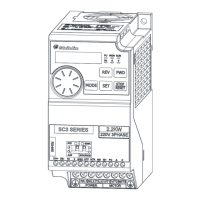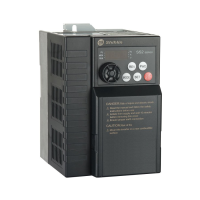Ways to measure voltage, current, power on main circuit
INSPECTION AND MAINTENANCE 163
6.2 Ways to measure voltage, current, power on main circuit
6.2.1 Selecting measurement instruments
Since inverter voltage and current on input side and output side includes harmonics, measurement data result may
vary. Choose the instruments below (with commercial power supply) for measurement.
Input side(R/L1、S/L2、T/L3)
Output side(U/T1、V/T2、W/T3)
Note: 1. Please pay attention to the instrument range and polarity;
2. Please pay attention to personal and property safety.
6.2.2 Measurement of voltage
Inverter input side
Input side voltage has a sine wave and with extremely small distortion, accurate measurement can be made with
an ordinary AC meter.
Inverter output side
Since the output side voltage has a PWM-controlled rectangular wave, always use a rectifier type voltmeter.
A pointer type meter cannot be used to measure the output side voltage as it indicates a value much greater than
the actual value.
A moving-iron type meter indicates an effective value which includes harmonics and therefore the value is larger
than that of the fundamental wave.
The value monitored on keypad is the inverter-controlled voltage itself. Hence, that value is accurate and it is
recommended to monitor values using keypad.
6.2.3 Measurement of current
Use moving-iron type meters on both the input and output sides of inverter. However, if the carrier frequency
exceeds 5kHz, do not use this type of meter since an overcurrent losses produced in the internal metal parts of the
meter will increase and may burn. In this case, use an approximate-effective value type.
Since current on the inverter input side tends to be imbalanced, measure three phases together is recommended.
Correct value cannot be obtained by measuring only one or two phases. On the other hand, the unbalanced ratio
of each phase of the output side current should be within 10%.
When a clamp ammeter is used, always use an effective value detection type. A mean value detection type
produces a large error and may indicate an extremely smaller value than the actual value. The value monitored
on keypad is accurate if the output frequency varies, and it is recommended to monitor values (provide analog
output) using the keypad.
6.2.4 Measurement of power
Use digital power meters at the input and output terminals of inverter simultaneously, or use electrodynamic
meters at the input and output terminals of inverter simultaneously. Then, measure the power by the 2-power
measurement method or the 3-power measurement method. However, the input terminal current tends to be
imbalanced, so it is recommended to use 3-power measurement method for measurement.

